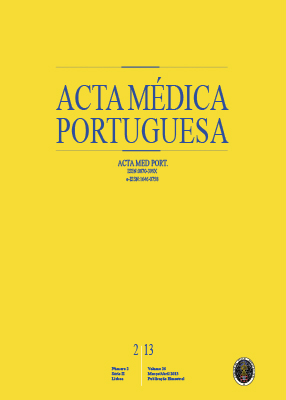Skin Cancer in Kidney Transplant Recipients: Incidence and Association with Clinical and Demographic Factors
DOI:
https://doi.org/10.20344/amp.4104Abstract
Introduction and Objectives: Organ transplanted recipients have a higher risk of non melanoma skin cancer. Our objectives were to determine incidence of skin cancer and search for associations with clinical or demographic factors in a series of kidney transplant recipients. Materials and Methods: A prospective study with face-to-face interview of 127 kidney transplant recipients who were observed for the first time during the second half of 2010 and in 2011. All diagnosed skin cancers were confirmed by histopathology. A 5% significance level was used and statistical analysis performed with chi-square, Fisher´s exact test or Mann Whitney test. Results: The mean age was 53 (s = 12.98) and 67% were males. The mean number of years since the transplant was 8 (s = 4.61) and skin cancer was observed in 16% (20 / 127), with equal number of basaliomas and squamous cell carcinoma. In sun exposed areas, actinic keratoses and viral warts were present in 24% and 8%, respectively. Skin cancer was significantly associated with older age (p = 0.016), longer duration of immunosuppression (p = 0.003) as well as with previous outdoor work (p = 0.049) or actinic keratoses in sun exposed areas (p < 0.001). Present intake of azathioprine (n = 8) was the only medication associated with skin cancer (p = 0.035 in Fisher´s exact test). Conclusions: Skin cancer incidence is high in our series and education about photoprotection should be given to these patients, as well as regular dermatologic surveillance. This regular follow up improves compliance with photoprotection measures and helps to decrease the incidence of non melanoma skin cancer.
Downloads
Downloads
How to Cite
Issue
Section
License
All the articles published in the AMP are open access and comply with the requirements of funding agencies or academic institutions. The AMP is governed by the terms of the Creative Commons ‘Attribution – Non-Commercial Use - (CC-BY-NC)’ license, regarding the use by third parties.
It is the author’s responsibility to obtain approval for the reproduction of figures, tables, etc. from other publications.
Upon acceptance of an article for publication, the authors will be asked to complete the ICMJE “Copyright Liability and Copyright Sharing Statement “(http://www.actamedicaportuguesa.com/info/AMP-NormasPublicacao.pdf) and the “Declaration of Potential Conflicts of Interest” (http:// www.icmje.org/conflicts-of-interest). An e-mail will be sent to the corresponding author to acknowledge receipt of the manuscript.
After publication, the authors are authorised to make their articles available in repositories of their institutions of origin, as long as they always mention where they were published and according to the Creative Commons license.









